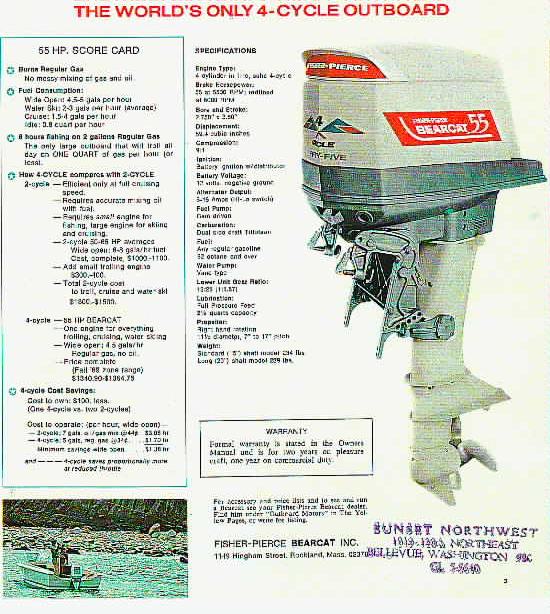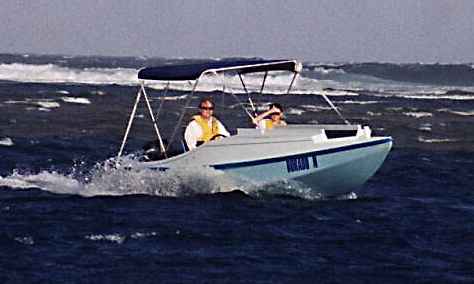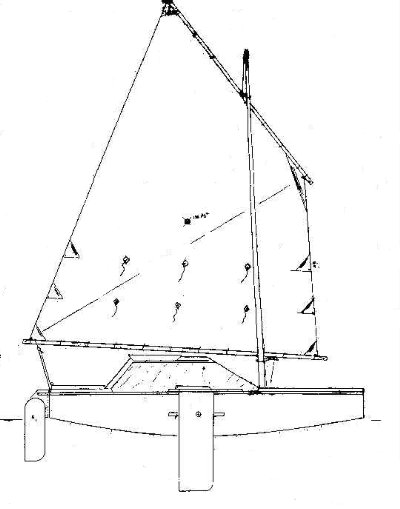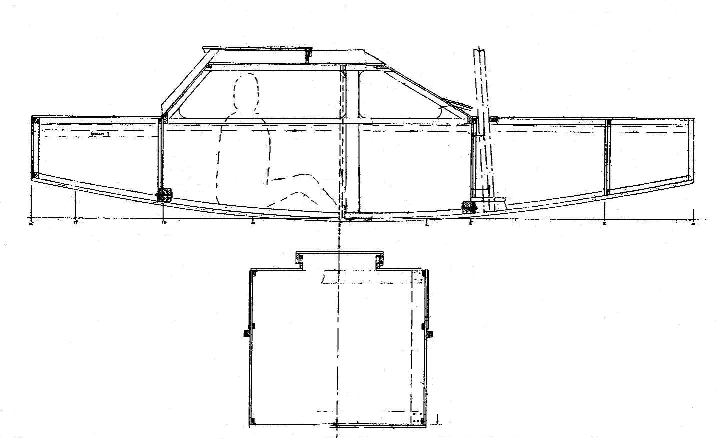
Doug Thomas takes his new LFH17 for a spin down in Florida.
Contents:
Contact info:
Jim Michalak
118 E Randall,
Lebanon, IL 62254Send $1 for info on 20 boats.
Jim Michalak's Boat Designs
118 E Randall, Lebanon, IL 62254
A page of boat designs and essays.
(15dec06) This issue will speculate on power requirements. The 1January issue will rerun that old article where I measure prop thrust.
THE BOOK IS OUT!
BOATBUILDING FOR BEGINNERS (AND BEYOND)
is out now, written by me and edited by Garth Battista of Breakaway Books. You might find it at your bookstore. If not check it out at the....ON LINE CATALOG OF MY PLANS...
...which can now be found at Duckworks Magazine. You order with a shopping cart set up and pay with credit cards or by Paypal. Then Duckworks sends me an email about the order and then I send the plans right from me to you.

|
Left:
Doug Thomas takes his new LFH17 for a spin down in Florida.
|
|
|
Figuring Power 2
RECAP....
I got another email last week replacing the one that got lost in the ether a while back concerning the possibility of an enlarged Dorado that would take an engine larger than called for on the original 18' Dorado. Turns out she has a Homelite four cycle 55 horse. I googled up this picture.

Here the motor is called a Fisher Pierce after they bought the rights to it but it is a Homelite, a Bearcat 55, same as the lady has. A nice piece of machinery. Homelite was about thirty years ahead of the times back in the 60's when they brought out a series of four cycle outboards, an interesting thing to do considering Homelite's fame as a maker of two cycle motors. She says the bare motor weighs 225 pounds. That is a lot more than the 30 horse Tohatsu two cycle Ashley used on the original Dorado (and he said it was plenty) but I suppose that weight is no more than the latest four cycles of the same power. ( And I must say the grande sized four cycles I see hung on the sterns are really HUGE! I was passing by a local dealer who was installing a 200 hp Honda four cycle on the stern of a big pontoon boat and he said it was the biggers and heaviest outboard they had ever dealt with.) Oh, yes. Here is a photo of Ashely Cook's original 18' Dorado...

NOW...
...we know the two important parts to the puzzle - how much power and how much the motor weighs. Here is how I would start the design. The old old rule of a horse for each fifty pounds of a planing hull is a very good one, I think. So this motor might plane a weight of 50 x 55 = 2750 pounds. In fact it might plane more. I suspect the 50 #/hp rule is a good one for deciding how much hp you need to buy for a certain rig and load. I know my AF4 is on a good plane at 12mph and 10 hp will get me there and my boat and rig weighs about 850 pounds total with me and some gear in it. Then the idea is to have a 15 on the stern cruising at 2/3 power at that speed. But we are here planing about 85 pounds per hp. But then again most folks might not think 12 mph is fast enough.
Anyway, it appears we could push 2750 pounds with that motor in an enlarged Dorado. Now, let us assume about 300 pounds total for motor installation and maybe another 100 pounds of fuel and let's add 800 pounds for a full crew and some gear and that all comes to 1200 pounds. Put it in a 1500 pound hull and we have it.
And then I might think that a well built AF4 hull weighs about 500 pounds. We can triple that weight with the 55 hp motor. Now, the cube root of 3 is 1.44. If you scaled up an AF4 hull by that much all its pieces would be 1.44 times as wide and 1.44 times as long and 1.44 times as thick and would weigh 3 times as much. So that AF4 would be 18 x 1.44 = 26' long. Well, I don't intend to scale Dorado up that much. Instead I am going for a more conservative 20%. Then the weight might increase 1.2 x 1.2 x 1.2 = 1.73 times 500 or a bare hull weight of about 860 pounds. So our full weight might be more like 860 + 225 + 100 + 800 = about 2000 pounds. At this stage that would be my best guess at the weight of a 20% enlargement of Dorado with some adults on board.
LAST TIME...

...we looked at a 20% stretch (just longer, not wider) of Dorado and used the Hullform program to estimate drag at different speeds. Hullform predicted an increase in drag of about 40% over the shorter standard Dorado but remember that I increased the weight by 20% also. How much of that drag increase is due to the extra weight? With Hullform it is simply a matter of typing a new weight to find out. So, for example, Hullform predicts about 195# of drag at 20 knots at 960 pounds. When I rerun the same long model at 800 pounds I get about 170# of drag so you see a lot of the extra drag is due to the extra weight of the longer boat.
Just for the fun of it I ran another model that was 20% wider (but not longer) than the original Dorado.

Weight for this one was taken to be 960 pounds as with the 20% longer model. Drag for this model was about 160#. Surprise! Quite a bit less than the longer model. So it appears that the Hullform professors feel that once on plane wider is better than longer.

MOVING ALONG TO THE 20% OVERALL ENLARGED DORADO...
...which is to say it is 20% longer, wider, and deeper. Here is a look at the Hullform model:

And here is a picture of Hullform's predicted drag for that boat over a range of weights...

Drag varies with weight. The weight to look at here is probably the 1500# line which is actually most in line, as far as comparisons are concerned, with the results for the standard 800# Dorado and the two 960# enlargements. At 20 knots this one has about 220 pounds of drag, compared to 130 pounds for the standard Dorado, 190 pounds for the 1.2 longer Dorado, and 160 pounds for the 1.2 wider Dorado.
Let us guess at horsepower here. At 24 knots we have about 320 pounds of drag for the 2000 pound boat. That is 768000 ft-lb/min which equates to 23 hp. If you recall in the last episode we guessed that only about a third of the rated hp of an older outboard seems to push the boat, so 55hp x .33 = 18 hp and maybe the 1.2Dorado won't go 24 knots with the older Homelite. At 22 knots drag appears to be about 290 pounds. That figures to be 19 hp so I would think the top speed of the 2000 pound Dorado would be about 21 to 22 knots.
At lighter weights the boat is faster but not as much as I would have thought. The 1500 pound boat looks to go about 23 knots on 18 hp, and the 1000 pound boat about 24+ knots. Anyway, that is what the Hullform professor thinks, although I'm pretty sure that doubling the boat's weight must make more difference than that.
Cruise speed? Let's say you are at 2/3 power, or about 12 hp pushing the boat. That happens at a little over 16 knots for the 2000 pound boat, at about 19 knots for the 1500 pound boat, and at about 20 knots for the 1000 boat.
ONE LAST ITEM...
...before we put the Hullform model away. The latest Hullform versions also allow you to plot drag vs speed at different cg locations. I will point out here that for the 120% enlarged Dorado that a cg which is 15' aft of the bow will give what most of us would think of as a "level trim" at rest (another gem we get from Hullform).

Notice that above 19 knots or so that the 18'cg location, which is aft to the extreme in a 22' hull, has a lot less drag than the forward postions. It has a huge "hump" of course at lower speeds and you have to power through that. Looks like if you plan to cruiser fast you must invite your guests to the stern as the speed picks up. We never saw this effect in AF4. It always seemed that it went better as the guests stepped forward but we weren't operating that fast. And wait a minute! - Don't those tiny racing hydro and runabout skippers always lean way way forward as they launch their boats, operating the controls with their toes? Then back into the driver's seat as the little job hops up on plane?
NEXT TIME...
We'll rerun that old prop thrust article.
Robbsboat

ROBBSBOAT, SAILBOAT, 15' X 4', 550 POUNDS EMPTY
Robb really probably wanted a Matt Leydon cruiser like Paradox but was put off by the complexity and small size. It has been a while since I saw Paradox plans but I think the "complexity" of the design is mostly in the details that made such a small boat livable. And maybe the only way to make a small boat like this work well in the Paradox fashion is to install all those details. However, my feeling is that almost no one is going cruising the way that Matt does and can get by without many of those details. My feeling is that Matt was able to make those trips in his little boats by very careful and patient planning and lots of experience. And if anyone were to ask me if this new boat is safe for ocean travel my answer would be a very quick and loud NO. In the right hands, like Matt's, it might be but it is the old case of "If you have to ask, the answer is NO." because the question demostrates you don't have enough experience to start with (like me).
But for a couple of days cruising on Kentucky lake, etc. by a small nimble person, it might work well, and that is what most of you will do if you are lucky. So the idea of Robbsboat is a small cruiser, totally enclosed, you sail it from the inside, you sleep in it, and it is supposed to take care of you and be self righting. Robb wanted it really sturdy so we have all 1/2" plywood with a bottom of double 1/2" plywood. Conventional construction including the only time I have ever used internal chine logs at Robb's insistance. That heavy plywood makes for a heavy boat - say 550 pounds stripped. The boat is supposed to be OK up to 1500 pounds total so a lot of gear can be stuffed inside. Some will think this is a two person cruiser, but they won't think that again after trying it on for size. If you tell someone they won't cruise with wife/girlfriend more than once I suppose 100% of them will disagree but you would be right for about 90% of them, so the boat will be a success 90% of the time. Much better than a really big boat that ends up being the wrong boat 90% of the time.

The sail rig shown is probably too large but then again it depends on the person and his cruising area. It is quite easy to reef or switch to a smaller sail since it is easy to get a balanced lug tuned up.
Eleven sheets of 1/2" plywood with conventional construction.
Plans for Robbsboat are $30 until one is built and tested.
Prototype News
Some of you may know that in addition to the one buck catalog which now contains 20 "done" boats, I offer another catalog of 20 unbuilt prototypes. The buck catalog has on its last page a list and brief description of the boats currently in the Catalog of Prototypes. That catalog also contains some articles that I wrote for Messing About In Boats and Boatbuilder magazines. The Catalog of Prototypes costs $3. The both together amount to 50 pages for $4, an offer you may have seen in Woodenboat ads. Payment must be in US funds. The banks here won't accept anything else. (I've got a little stash of foreign currency that I can admire but not spend.) I'm way too small for credit cards.
I think David Hahn's Out West Picara is the winner of the Picara race. Shown here on its first sail except there was no wind. Hopefully more later. (Not sure if a polytarp sail is suitable for a boat this heavy.

Here is a Musicbox2 I heard about through the grapevine.

We have a Philsboat going together in California. You can see the interior room in this 15' boat:

And here is another Philsboat in northern Illinois:

Well, we have an LFH17 in the water but it is not the project that we have shown here in the last few issues. Doug Thomas completed the first LFH17 in Lakeland, Florida. Rowing report soon...

HOLY COW! A Jukebox2 takes shape in Minnesota. Unheated shop means no work during the winter. Check out that building rig!

And the Vole in New York. Going very quickly but most likely there will be little more done during the cold winter.

AN INDEX OF PAST ISSUES
Hullforms Download (archived copy)
Plyboats Demo Download (archived copy)
Brokeboats (archived copy)
Brian builds Roar2 (archived copy)
Herb builds AF3 (archived copy)
Herb builds RB42 (archived copy)